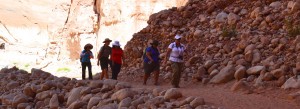National Parks Work to Overcome Heavily Skewed Demographics of their Visitors
Jesse Baum

A Vista in Yellowstnoe National Park. According to national averages, only one in ten of the park’s visitors are nonwhite. Image courtesy of destination360.com
The author Wallace Stegman said “”National parks are the best idea we ever had. Absolutely American, absolutely democratic, they reflect us at our best rather than our worst.” However, a recent NY Times article called this idea of egalitarian into question, writing that white Americans still use the National Parks at a far higher rate than any other demographic, with only twenty percent nonwhite visitors, and ten percent Latino visitors. Apart from the Parks’ worry that in the future this will mean fewer people using the parks at all, which is disheartening as the parks provide amazing opportunities for recreation and connection with nature.
Additionally, studies have shown that spending time outside and being around nature can improve children’s performance in school, improve respiratory health and physical fitness, relieve stress and restore concentration skills – so groups that do ot use the parks are deprived of these benefits. Geoffrey Godbey, a Professor Emeritus at Penn State University in the Department of Parks and Recreation suggested that this gap is a symptom of greater divides- owning a car, for instance, and proximity to “wilderness” as a whole.
What’s even more discouraging is that this inequality persists even into urban areas, with more affluent, and generally white areas having safer and better managed parks than those in lower class areas.
For the national parks, this inequality has meant extensive demographical research, working with nonprofits that organize outdoor recreation targeted at “young minorities”, as well as partnering with companies such as REI (an outdoor gear outfitters company) sponsor outdoor trips. Parks have been working to combat the white ideal of hunting and frontiersmen by constructing more monuments to American heroes such as Cesar Chavez (founder of el Teatro Campesino) and Harriet Tubman that will be managed by the Parks Service. In addition, congress now funds American Latino Heritage Fund of the National Park Foundation, which also sponsors trips to National Parks. Park officials hope that the initial visit will encourage the newcomers to revisit the parks.
However, some worry that the parks simply cannot convince people to try activities that their families never engaged with, nor compete with the resort model for vacationing. And various ideas for attracting young people- such as having more widely available wi-fi, or hosting concerts, seem in glaring contrast for the isolation that has been the romanticized ideal for the parks for decades.

Hikers with the American Latino Heritage Fund. The fund, a non-profit that works with the national parks, strives to make the national parks appealing and relevant to people with Latino backgrounds, and sponsors trips to national parks around the country for Latino men and women. Image courtesy of American Latino Heritage Fund
For now, though it’s clear that engaging with the largest demographic in America will be crucial for the parks, visitors that arrive via the various initiatives are often shocked by the obvious lack of diversity. Carol Cain, a visitor to Olympic National Park in Washington State that came with American Latino Expeditions said “We’ve been here for two days, walking around, and I can’t think of any brown person that I’ve seen,” said Carol Cain. The NY times Article went on to say that some that visited the parks wanted to warn future visitors about the sense of isolation that they had during the trip, while others were concerned it would stop people from going.
Altogether, the problem of diversity in the parks is a question of chicken and egg- because the absence of minorities means that a whole group is missing out on the amazing experience of the parks and the advantages that they can give, but also the question of a racially divided America, where only the upper (and generally Caucasian) class can afford leisure.
A link to the New York Times article may be found here
